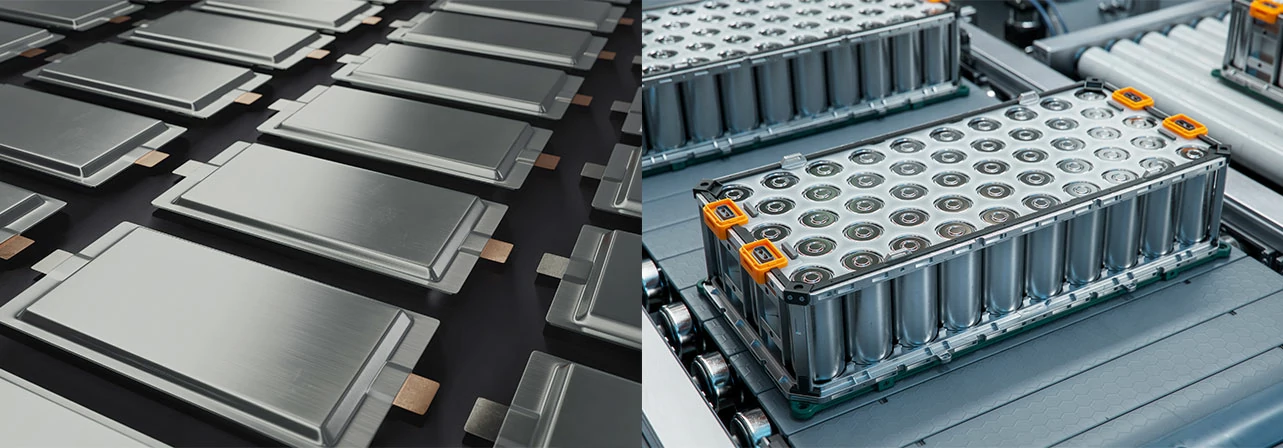Drone Battery Production Process: Precision and Innovation for UAV Power Systems
The drone battery production process combines advanced manufacturing techniques with rigorous quality control to deliver lightweight, high-energy-density power solutions essential for modern UAVs.
As drones increasingly dominate industries like logistics, agriculture, and surveillance, understanding this process—from electrode preparation to final testing—ensures reliability, safety, and optimal performance. This article outlines the drone battery production process, emphasizing cutting-edge methodologies and industry standards that define next-generation UAV power systems.
Drone Battery Production Process: Key Steps for High-Performance UAV Power Solutions
Eight core process modules in detail
The production process begins with electrode preparation, a critical phase determining battery efficiency. First, active materials (e.g., lithium cobalt oxide for cathodes or graphite for anodes) are mixed with binders and solvents to form a slurry.
This slurry is uniformly coated onto metal foils (aluminum for cathodes, copper for anodes) using precision coating machines. After drying, the coated foils undergo calendaring to compress layers, ensuring consistent thickness and density. Finally, slitting machines cut electrodes into precise dimensions, ready for assembly.
High-quality electrodes require strict moisture control, as even trace water can degrade performance. Advanced facilities utilize dry rooms or nitrogen-filled environments to maintain humidity below 1% during this stage.
Next, electrodes are combined with separators to form battery cells. For drone batteries, manufacturers often choose between two methods:
• Stacking (Lamination): Ideal for prismatic or pouch cells, this method layers alternating anode, separator, and cathode sheets. It maximizes energy density and allows flexible shapes, making it popular for compact UAV designs.
• Winding: Used for cylindrical cells, this technique rolls anode-separator-cathode layers into a jelly-roll structure. While less common in high-end drones, it offers cost efficiency for standardized models.
Both methods demand precision alignment to prevent internal short circuits. Automated robotic systems ensure micron-level accuracy, while laser welding secures tabs to collect current efficiently.
After cell assembly, electrolyte—a lithium salt dissolved in organic solvents—is injected into the cell under vacuum conditions. This step requires meticulous control to avoid air bubbles, which can cause overheating. The cell is then hermetically sealed using laser welding or heat pressing, depending on the casing type (pouch, prismatic, or cylindrical).
Drone batteries often employ lightweight pouch cells with aluminum-laminated films, balancing durability and weight reduction. Post-sealing, cells undergo a formation process, where initial charging activates electrochemical reactions and stabilizes capacity.
Before integration, batteries enter an aging phase, where they are stored at controlled temperatures for 7–14 days. This step identifies early defects, such as self-discharge abnormalities. Subsequently, rigorous testing protocols validate performance:
• Electrical Testing: Measures voltage, capacity, and internal resistance to ensure compliance with specifications.
• Safety Testing: Includes overcharge/discharge tests, thermal shock trials, and nail penetration simulations to assess fire resistance and stability.
• Environmental Testing: Evaluates performance under extreme temperatures and vibrations, mimicking real-world UAV operating conditions.
Manufacturers adhere to standards like UL 3030, which certifies lithium-ion batteries for commercial drones, minimizing risks of thermal runaway.
In the final stage, individual cells are grouped into battery packs tailored for UAVs. A battery management system (BMS) is integrated to monitor voltage, temperature, and charge cycles, preventing overloading and balancing cell performance. High-current connectors and lightweight wiring harnesses ensure efficient power delivery to drone motors.
For premium drones, packs may incorporate carbon fiber casings to reduce weight while maintaining structural integrity. Post-assembly, packs undergo a final round of functional tests, including flight simulation, before certification.
Packaging System Technology Evolution Trends
From electrode slurry mixing to intelligent pack assembly, the drone battery production process prioritizes precision, safety, and adaptability.
As UAV technology advances, innovations like solid-state electrolytes and AI-driven quality control will further enhance energy density and reliability. By adhering to stringent manufacturing protocols, producers can meet the growing demand for durable, high-performance batteries that power the future of aerial innovation.

UAV DRONE battery
Enov UAV battery has the most advanced UAV battery new technology, it has a lightweight structural design, ultra-high energy density, stable continuous discharge, customized ultra-high instantaneous discharge, wide temperature working range, stable charge and discharge, battery materials can choose high nickel terpolymer positive/silicon carbon negative material system combined with semi-solid battery technology. Or choose a more mature application of more UAV lithium battery technology, available UAV battery nominal voltage 3.7V, capacity 18.0Ah ~ 30.0Ah, support 10C continuous discharge and 120C pulse discharge (3 seconds). With ultra-high energy density (220-300Wh/kg) as its core advantage, Enov UAV batteries can meet the needs of long-term endurance scenarios such as plant protection drones and transport drones, while maintaining stable emission performance in extremely low temperature environments (-40℃).
Other products
START-STOP LITHIUM BATTERY
LITHIUM ENERGY STORAGE BATTERY
QUICK INQUIRY
FAQ
Access to high frequency technical questions with one click, get accurate answers on product application, after-sales policy and customization process.
Service and Support
Get the latest product specifications, explore professional OEM/ODM customization services, click to open exclusive technical support and production solutions.
Become a Partner
We sincerely invite resources to interconnect, work together for win-win development, and immediately open a new chapter of strategic cooperation!








